No products in the cart.
No products in the cart.
No products in the cart.
No products in the cart.
Home » Neurological Recovery Blog » Cerebral Palsy » Helpful Adaptive Equipment for Cerebral Palsy Management
Last updated on December 8, 2021

Because cerebral palsy can limit a person’s mobility, using adaptive equipment can help individuals perform everyday tasks that they may not be able to do otherwise. As a result, adaptive equipment helps maximize an individual’s functional abilities and encourages them to be more independent.
This article will share some of the best adaptive equipment for individuals with cerebral palsy.
There are a variety of adaptive tools and equipment that can help individuals with cerebral palsy become as functional as possible. Because everyone experiences cerebral palsy differently, some tools may be more ideal for individuals with certain types of cerebral palsy than others.
For example, if an individual only experiences motor impairments in the legs, adaptive tools for the arms and hands won’t be necessary.
Below, we’ll share 10 adaptive tools that can help boost mobility and functional independence in individuals with cerebral palsy.
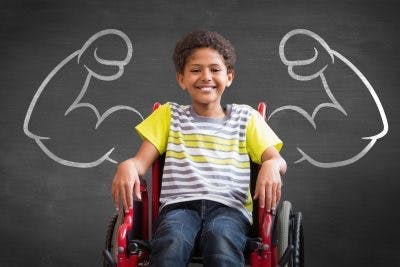
Children with cerebral palsy may have difficulties walking due to irregular muscle tone in their hips and legs or poor trunk stability. A wheelchair can help individuals get to where they need to go independently.
Some people with cerebral palsy may have impaired motor control throughout their upper body and lower bodies and consequently, may not be physically able to operate a manual wheelchair. In such cases, it will be ideal to utilize a power wheelchair or power scooter.
Depending on their needs and insurance coverage, some individuals with cerebral palsy may even be able to get a standing power wheelchair. These can further promote use of the legs in a safe, supported position, and can increase social participation and inclusion with peers.
A physical therapist, occupational therapist, or assistive technology professional (ATP) can help you get a wheelchair personalized to an individual’s specific needs. This may include having specific cushion styles, positioning devices, and power functions, in addition to choosing from various colors and accessories.

A gait trainer will help children with cerebral palsy develop their walking skills. Gait trainers can vary in design; some will come with a built-in harness to prevent falling while others will be designed for postural alignment and support from behind.
A gait trainer allows your child to practice bearing and shifting their body weight. This helps strengthen the muscles and bones and prevents them from atrophying. A gait trainer can also help prevent the development of leg contractures by promoting movement.
Want 19 pages of CP recovery tips in PDF form? Click here to download our free illustrated ebook now (link opens a pop up for uninterrupted reading)
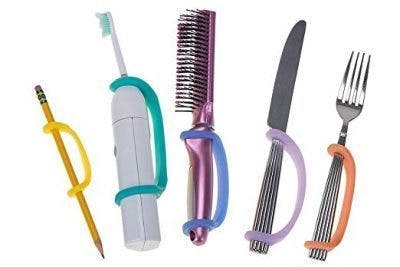
Universal cuffs are versatile adaptive tools that can help children with motor impairments in their hands perform tasks that require fine motor skills such as gripping.
They can be attached to objects like toothbrushes, utensils, and pencils. They create a handle and/or larger grip so that the object is easier to hold.
A universal cuff will help promote children’s independence by allowing and encouraging them to practice more tasks on their own.
Find universal cuffs on Amazon »
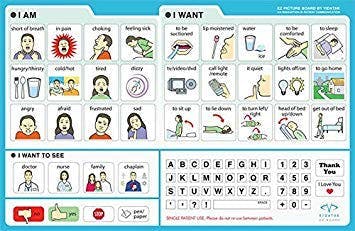
Some children with cerebral palsy have speech impairments that interfere with their ability to communicate with others. Many children with speech impairments are very intelligent; they just lack the motor control over their oral muscles needed to produce speech.
Utilizing a communication board can promote better speech and language skills by combining sounds with a visual aid. Communication boards can be as simple as one printed board with pictures, or more advanced, such as multiple boards integrated into book form (like a PODD book). They can also be technology-based, such as those designed to be used on an IPad or other electronic device.
Generally, a speech-language pathologist (SLP) will teach your child how to use a communication board. An SLP can also design personalized communication boards for specific situations and interests a child may have.
Check out the video below for an example of how communication boards work.
Find communication boards on Amazon »

If cerebral palsy affects the hands and arms, individuals may struggle to grip utensils or bend their wrists. Adaptive utensils can help encourage children with cerebral palsy to eat on their own.
There are many different types of adaptive utensils for varying levels of motor impairments. Some adaptive utensils will have larger grips so that the handles are easier to hold. Others might bend to a certain angle or have handles/straps that wrap around the arm to prevent being dropped. Still others are weighted to limit the effects of tremors.
Find adaptive tools on Amazon »
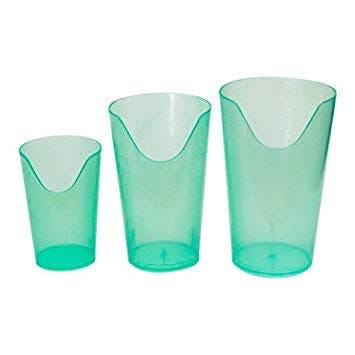
Another adaptive tool that will promote independent feeding in children with cerebral palsy is a nosey cup. It’s designed to keep your child from spilling while drinking.
The curve in the top of the cup allows space for your child’s nose, so they can lift the cup to drink without tilting their head as much.

Children with severe motor impairments in their legs and unaffected upper body motor control may benefit from using a leg lifter. They make transferring in and out of wheelchairs and into bed much easier.
To move the legs, simply place one foot inside of the loop and pull the rope.

Braces can help keep the body aligned and limit spasticity in the neck, torso, arms, and legs.
They promote proper positioning to prevent developmental deformities or contractures caused by spasticity and help prevent uncontrollable movements. They also can help build strength and gently stretch tight muscles, even when your child is not actively exercising.
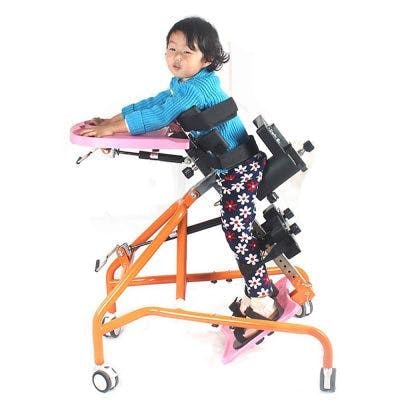
A standing aid is a piece of adaptive equipment that can help children with cerebral palsy develop strength in their legs by encouraging them to bear their own weight.
Standing aids also help promote postural symmetry, circulation to the lower extremities, and muscle endurance.
With the help of a standing frame, children may gradually learn to stabilize themselves in an upright position, which brings them one step closer to standing on their own.
Find standing frames on Amazon »

Kids with CP may find it difficult to sit upright in the bathtub because of poor balance skills and the slippery environment. A bath chair will help children stay in place during their baths and provide additional neck and back support.
One of the best ways for individuals with cerebral palsy improve their motor functions is practice moving with correct form as much as possible.
Physical and occupational therapy can be extremely effective to help individuals perform the repetitions they need to stimulate adaptive changes in brain. However, the repetitions performed in a weekly therapy session are not enough. Therefore, it is essential for individuals with cerebral palsy to also practice the exercises and activities they learn in therapy at home as well.
While it sounds simple, many individuals struggle to stay motivated to practice at home. This is where investing in at-home neurorehabilitation devices can help drive functional improvements.
For example, FitMi is a full-body physical therapy device that turns your everyday exercise routine into a fun, interactive game. By interacting with the sensorized pucks and following the challenges displayed on the screen, individuals remain engaged and are more likely to practice the exercises they need to improve their movements.
If you’re specifically looking for a tool to help improve hand functions affected by cerebral palsy, MusicGlove is ideal. In fact, it’s clinically proven to improve hand function in just 2 weeks.
This device combines music, gaming, and hand therapy to encourage users to perform high repetitions of thumb-finger opposition movements. By developing these movements, individuals can improve their ability to grasp objects and perform everyday tasks such as turning a doorknob.
In the following section, we’ll discuss why focusing on therapeutic exercise is ideal for cerebral palsy management.
The use of adaptive equipment to manage cerebral palsy involves two primary goals. The first is to help individuals perform everyday tasks on their own. The second is to encourage improvements by promoting neurological adaptations in the brain through highly repetitive practice.
Individuals with cerebral palsy should be using adaptive tools with the intention of no longer needing them in the future. The best way to do this is to continuously practice the associated task, which will stimulate the brain and reinforce demand for that function.
The brain’s ability to adapt (neuroplasticity) is promoted through consistent repetition. Moreover, children’s brains are capable of learning new skills faster than adult brains. Therefore, it’s ideal to use adaptive tools to develop daily living skills as early as possible.
Once your child gets comfortable using adaptive tools, it’s a good idea to find a more challenging alternative or have them try the task without the tools. This will stimulate new pathways in areas of the brain that are not affected by damage. These new pathways could potentially replace movement patterns affected by cerebral palsy. The more your child practices these new skills, the stronger the neural pathways for them will become.
Adaptive equipment can help individuals with cerebral palsy maximize their functional independence. These tools encourage individuals to be more physically active and practice movements affected by motor impairments.
However, individuals with cerebral palsy should also try to avoid overdependence on adaptive tools and try to practice these tasks without them when possible. This will help stimulate neuroplasticity and encourage better motor control.

Get our free 19-page PDF full of helpful tips for cerebral palsy by signing up below! If you liked this article, you’ll LOVE our free ebook.
When you sign up, you’ll also receive our popular emails that share more tips for life with cerebral palsy — you can opt out anytime.
We will never sell your email address, and we never spam. That we promise.


At Flint Rehab, we understand that doing physical therapy at home can become tedious and repetitive. But when repetition is critical to recovery, it’s important to stick with a repetitive regimen. But that doesn’t mean it has to be boring.
Flint Rehab is the leading manufacturer of motion-sensing, gamified rehabilitation devices. Our bestselling recovery tool, FitMi, transforms full-body rehab exercises into an interactive experience.
See what individuals with CP are saying about FitMi:
“The FitMi and MusicGlove have done wonders for my son with hemiparesis from cerebral palsy and stroke. It motivates him to do his exercises. It does not seem like therapy for him since it is fun. FitMi monitors his progress so it is a great reinforcement for him. Music is a motivator for him. He has been using it on his arm and we will try the leg exercises soon.”
-Manning
While FitMi is a recovery tool for the full-body, our other device, MusicGlove, helps target the hand to improve fine motor skills and dexterity.
See what others have said about MusicGlove:
“My granddaughter has right-side hemiplegia from Cerebral Palsy / stroke at birth. She states that this is a great product for anyone who has issues with the use of their hand(s), and that is has helped her tremendously. She also finds the music quite catchy (surprisingly!). Our occupational therapist has been impressed as well. I can say that it has arguably been the best tool of all our therapy resources.”
-Jenni
Together, FitMi and MusicGlove make a powerful home therapy regimen for individuals with cerebral palsy. Best of all, you can save money when you bundle them together.
To learn more, click the button below:

Do you have these 19 pages of helpful tips for CP?
Get a free copy of our ebook Helpful Tips for Managing Cerebral Palsy. Click here to get instant access.
Grab a free rehab exercise ebook!
Sign up to receive a free PDF ebook with recovery exercises for stroke, traumatic brain injury, or spinal cord injury below: